Introduction
Care for a puppy without mother might feel like trying to build a house without a blueprint — daunting, but totally doable with the right knowledge and love. Let’s break it down and help you become the best stand-in parent your little furball could ask for!
Table of Contents
What Is The Need Of Care For A Puppy Without Mother

There are many reasons to Care for a puppy without mother.All of them are discussed below:
| Reason | Explanation | Condition |
|---|---|---|
| In case Mother has died | If the mother dies during or after giving birth to puppies & puppies have no one to nurse them. | Example: Severe complications during birth (dystocia) or severe infection (e.g., pyometra) in the mother. |
| If Mother is ill or too much weak | If the mother is too ill or too weak, and unable to produce enough milk or may reject the puppies. | Example: Eclampsia (low calcium), Mastitis (breast infection), Severe loss of blood |
| Mother has no milk (agalactia) | Sometimes mothers fail to produce milk, or milk is very poor in quality. | Example: Hormonal problems, premature birth of puppies, stress after birth. |
| Puppies Rejection by mother | Some mothers refuse to nurse their puppies, especially first-time mothers or if stressed. | Example: Mother growls at or ignores puppies, leaves them alone. |
| Mother becomes aggressive ortry to attack puppies | Rarely, the mother may harm or even kill the puppies instead of caring for them. | Example: Inexperienced or very nervous mother bites puppies. |
| Puppies are too weak to nurse | If puppies are too weak, premature, or have birth defects, they may not be able to suckle properly. | Example: Cleft palate, very small size (runt), or low birth weight. |
| Large litter size | If there are too many puppies, the mother may not have enough milk or nipples for all. | Example: A mother with 10+ puppies but only 6–8 nipples — smallest puppies may starve. |
| Infectious disease risk | If the mother has a contagious disease, her milk or contact may harm the puppies. | Example: Canine herpesvirus, brucellosis, or severe mastitis. |
Foster Mother Option To Care For A Puppy Without Mother
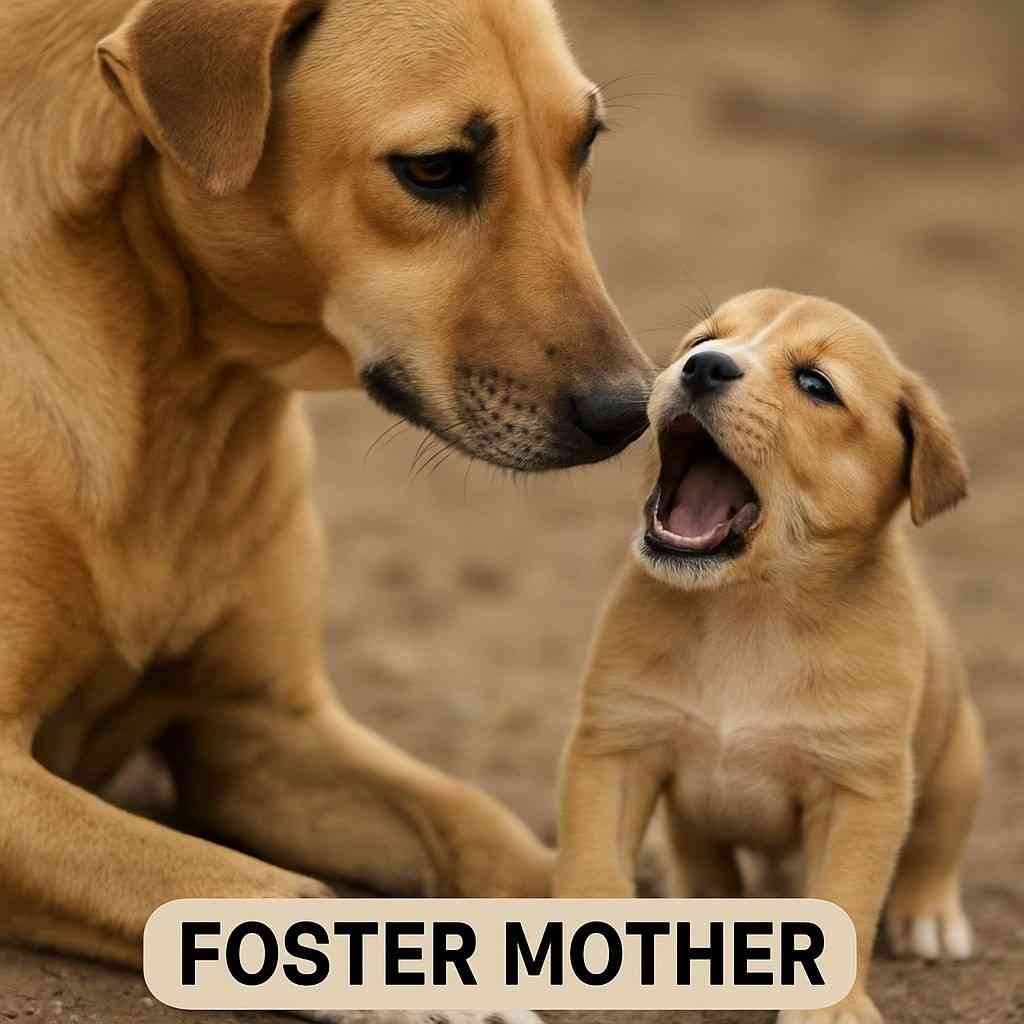
A foster mother, typically a lactating female dog, can be used to care for a puppy without mother by providing essential nutrition, warmth, and socialization.While choosing foster mother as an option to care for a puppy without mother,we have to remember some aspects:
| Aspect | Explanation | Scientific Basis |
|---|---|---|
| Nutrition | The foster mother provides milk, which is crucial for the puppy’s growth and immunity. | Dog milk contains colostrum (rich in antibodies) and nutrients like proteins, fats, and carbohydrates, supporting the puppy’s immune system and development. |
| Warmth and Comfort | The foster mother keeps the puppy warm through physical contact, mimicking natural conditions. | Puppies cannot regulate body temperature effectively until 4-6 weeks. The foster mother’s body heat maintains the puppy’s temperature around 36.1–38.3°C (97–101°F). |
| Socialization | The foster mother teaches the puppy social behaviors through interaction and grooming. | Early socialization (3-12 weeks) is critical for behavioral development, reducing stress and aggression later in life, as the puppy learns canine cues from the mother. |
| Stimulation for Elimination | The foster mother licks the puppy to stimulate urination and defecation. | Orphaned puppies under 3 weeks cannot eliminate waste independently. The mother’s licking triggers the anogenital reflex, aiding digestion and waste elimination. |
| Emotional Bonding | The foster mother provides a sense of security, reducing stress for the puppy. | Oxytocin release during nursing and contact promotes bonding, lowering cortisol levels and supporting mental health. |
| Immune System Support | Milk from the foster mother transfers antibodies, protecting the puppy from infections. | Colostrum contains immunoglobulins (IgG, IgA) that provide passive immunity, critical for puppies before their immune systems mature (around 6-8 weeks). |
Basic Requirements
- Compatibility: The foster mother should be healthy, vaccinated, and have a compatible temperament to accept the orphaned puppy. Gradual introduction with scent swapping (rubbing the puppy with the mother’s bedding) can improve acceptance.
- Monitoring: Ensure the puppy is nursing properly and gaining weight (10-15% body weight daily in the first week). If the foster mother rejects the puppy, bottle-feeding with a puppy milk replacer may be needed.
- Age Consideration: Puppies under 4 weeks rely heavily on the foster mother for milk and stimulation. After 4-5 weeks, weaning can begin, reducing dependency.
Challenges While Transfering To Foster Mother
Using a foster mother for care for a puppy without mother can be highly beneficial, but several challenges may arise during the process.
| Problem | Description | Scientific Basis | Possible Solutions |
|---|---|---|---|
| Rejection by Foster Mother | The foster mother may refuse to accept or nurse the orphaned puppy. | Dogs rely on scent and familiarity; an unfamiliar puppy may trigger rejection due to lack of maternal recognition or stress. | Gradually introduce the puppy by rubbing it with the foster mother’s bedding to transfer her scent. Monitor interactions and separate if aggression occurs. |
| Insufficient Milk Production | The foster mother may not produce enough milk to feed the orphaned puppy. | Milk production depends on the mother’s health, litter size, and lactation stage. A large litter or poor nutrition can reduce milk supply. | Supplement with puppy milk replacer. Ensure the foster mother is well-fed with a high-calorie, nutrient-rich diet to boost milk production. |
| Competition with Other Puppies | The foster mother’s own puppies may outcompete the orphaned puppy for milk. | Stronger or larger puppies may dominate nursing, leaving the weaker orphan underfed, leading to malnutrition or failure to thrive. | Supervise nursing to ensure the orphan gets access to milk. Hand-feed the orphan with milk replacer if necessary to meet nutritional needs. |
| Health Risks to Puppy | The foster mother may transmit infections or have health issues affecting the puppy. | Diseases like canine herpesvirus or parasites can spread through milk or contact, especially if the foster mother is not vaccinated or healthy. | Ensure the foster mother is vaccinated, dewormed, and screened for infections. Monitor the puppy for signs of illness (e.g., diarrhea, lethargy). |
| Inadequate Stimulation | The foster mother may not stimulate the puppy enough for elimination. | Puppies under 3 weeks require anogenital stimulation to urinate and defecate. Inconsistent stimulation can cause constipation or urinary retention. | Manually stimulate the puppy’s anogenital area with a warm, damp cloth if the foster mother does not perform this role adequately. |
| Stress or Behavioral Issues | The orphaned puppy may experience stress or fail to learn proper canine behaviors. | Lack of proper socialization or rejection can elevate cortisol levels, impacting development and behavior (e.g., fearfulness or aggression). | Provide a calm environment, encourage gentle interaction with the foster mother, and introduce socialization with humans and other dogs gradually. |
Alternatives
- Monitoring: Regularly check the puppy’s weight (should gain 10-15% daily in the first week) and behavior to identify issues early. Veterinary consultation is critical if problems persist.
- Foster Mother’s Capacity: Assess the foster mother’s physical and emotional capacity to handle an additional puppy, especially if she has a large litter.
- Backup Plan: If fostering fails, be prepared to hand-rear the puppy with milk replacers, warmth (e.g., heating pads), and manual stimulation, mimicking the foster mother’s role.
Recognizing the Demands of an Orphaned Puppy
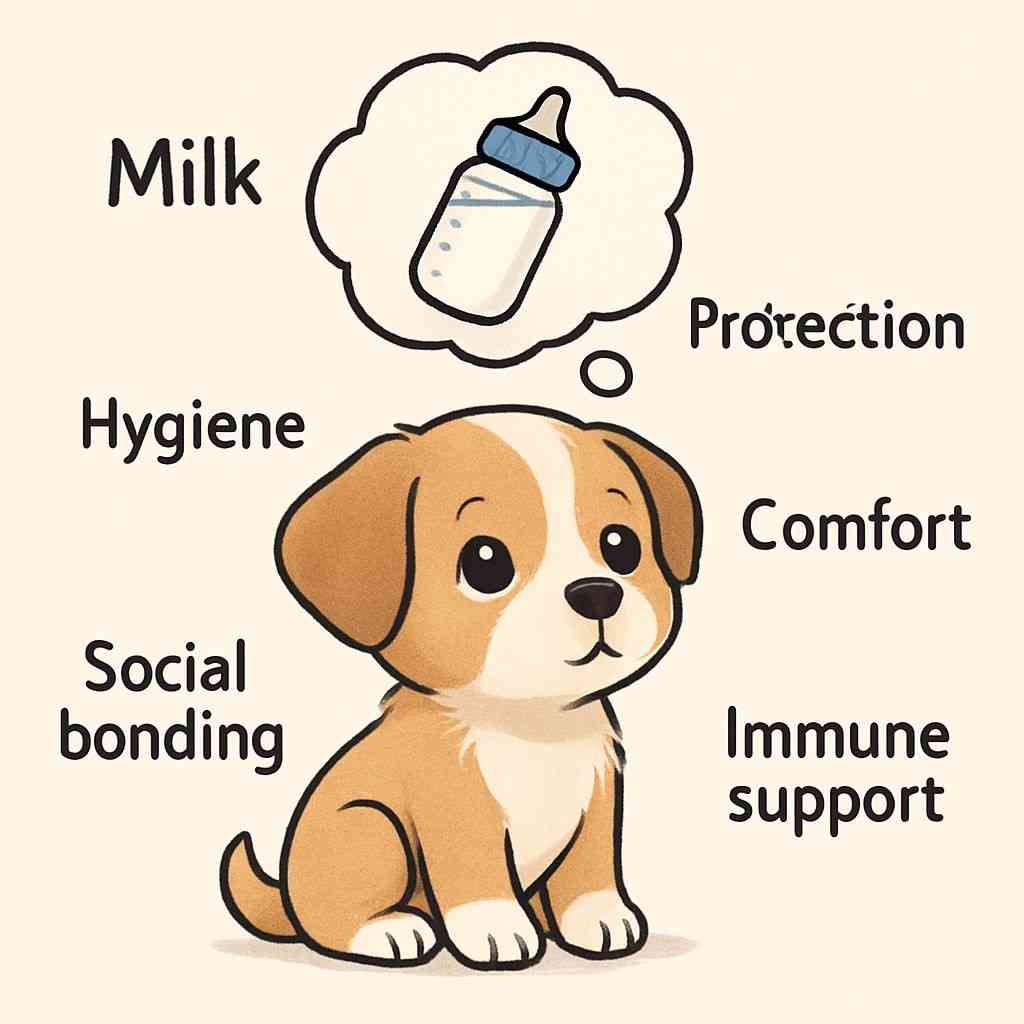
| Need | If Mother is Present | If Mother is Not Available |
|---|---|---|
| Nutrition (milk) | Mother’s milk provides colostrum (antibodies) & nutrition. | Feed a commercial canine milk replacer (not cow’s milk) using a bottle or syringe every 2–3 hours. |
| Warmth & Temperature | Mother provides body heat. Puppies stay close to her. | Use a heating pad, hot water bottle (well covered) or heat lamp to keep area ~30–32°C (86–90°F) for the first week, reducing gradually. |
| Hygiene & Elimination | Mother licks the puppy to stimulate urination & defecation. | After each feeding, gently rub the puppy’s genital area with a warm, damp cotton ball or cloth to stimulate elimination. |
| Protection & Comfort | Mother keeps puppies safe & calm. | Keep in a clean, draft-free, quiet box or incubator. Handle gently & minimize stress. |
| Social interaction & bonding | Mother and littermates provide early social experiences. | Provide gentle handling & later socialization with people & other dogs as they grow. |
| Immune support | Colostrum from mother within first 24 hrs gives antibodies. | If colostrum missed, consult vet for possible plasma or serum therapy; keep environment extra clean to reduce infection risk. |
Preparing to Care for a Puppy Without Its Mother
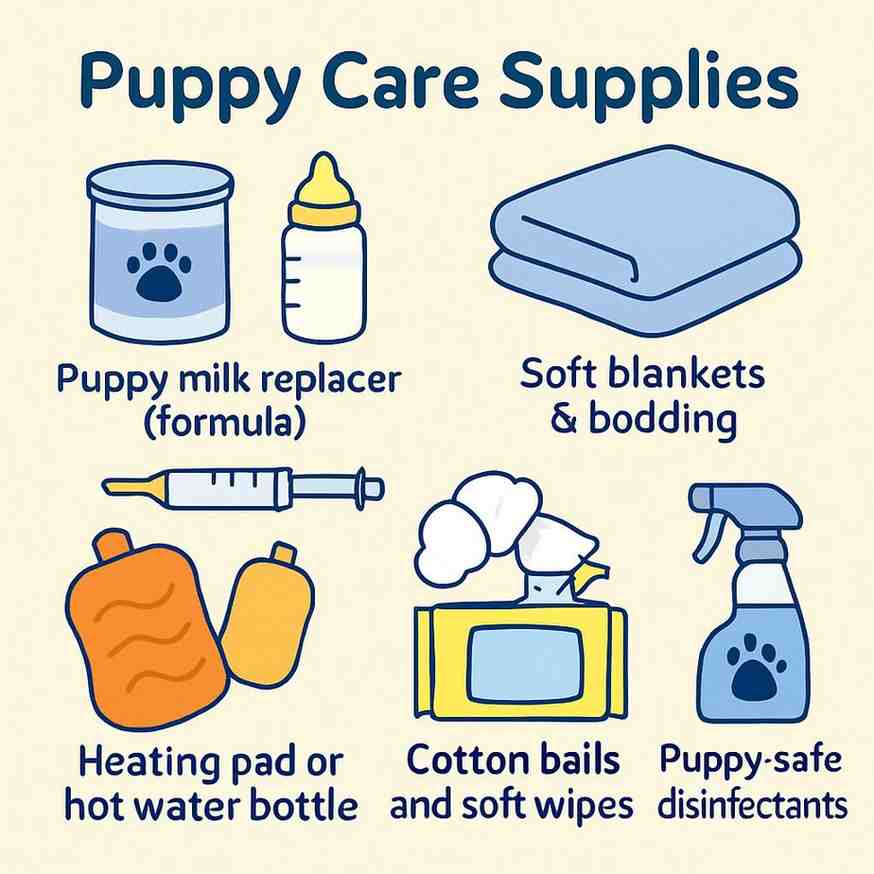
- Puppy milk replacer (formula)
- Nursing bottles or syringe
- Soft blankets & bedding
- Heating pad or hot water bottle
- Cotton balls and soft wipes
- Puppy-safe disinfectants
🍼 1. Puppy Milk Replacer (Formula)
| What it is | A special milk formula designed to meet the nutrition needs of puppies. |
|---|---|
| Why it’s needed | Cow’s milk is not suitable — too much lactose & not enough protein & fat. Puppies need proper nutrition to grow & build immunity. |
| Examples | Commercial products with high qualities should be taken |
| How to use | Mix as per package directions; feed warm (about body temperature) using bottle or syringe. |
Homemade Puppy Milk Replacer & How To Prepare It
Warm the goat’s milk (or cow’s milk) to about body temperature (not hot).
✅ Stir in the yogurt, egg yolk, and honey until well mixed.
✅ Make sure it’s smooth — no lumps.
✅ Use a clean bottle or syringe to feed.
Milk Replacer Amounts for Newborn Puppies
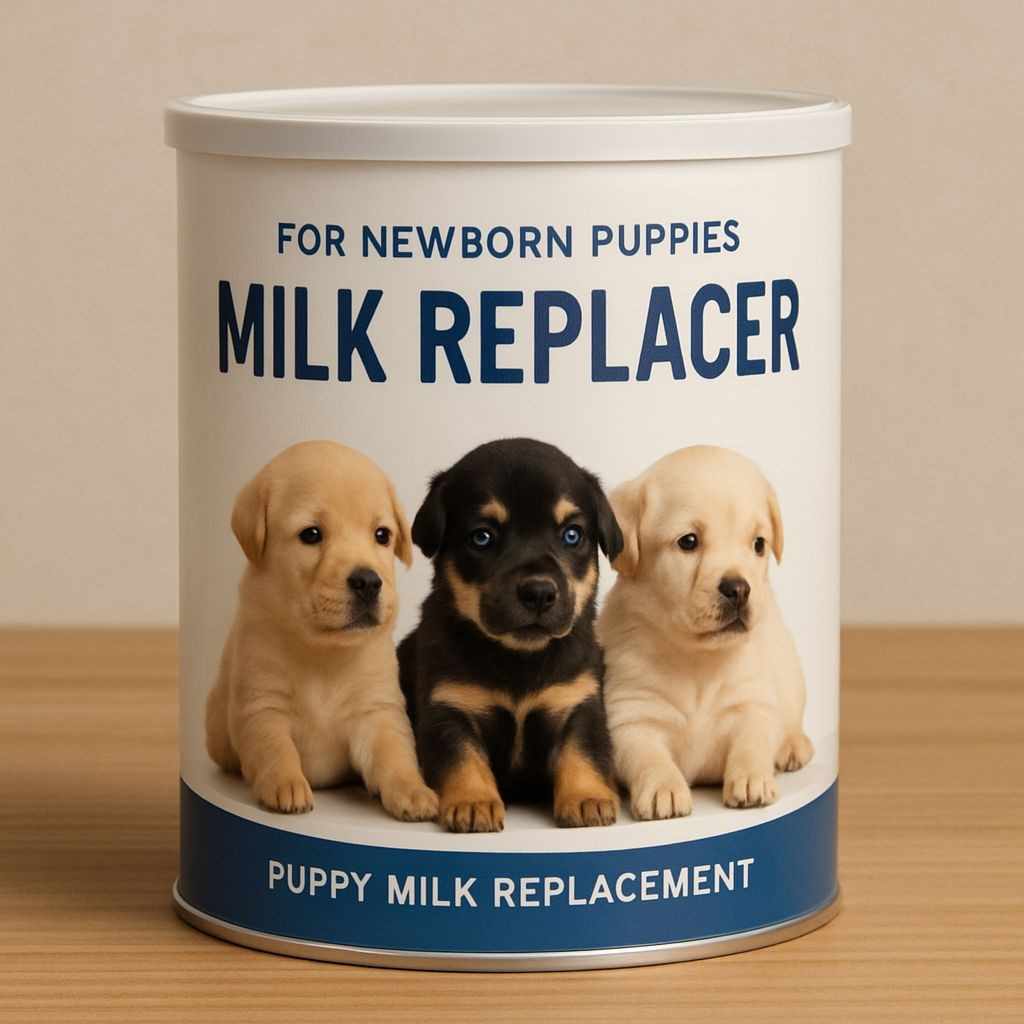
| Puppy’s Age | Daily Amount of Milk Replacer | Per Feeding (if fed every 2–3 hrs) | Notes |
|---|---|---|---|
| Day 1–3 | ~13–15 ml per 100 g body weight per day | ~1.5–2 ml per 100 g per feeding | Includes colostrum if possible; feed more frequently (every 2 hrs). |
| Day 4–7 | ~16–18 ml per 100 g per day | ~2–2.5 ml per 100 g per feeding | Feed every 2–3 hours, including at night. |
| Week 2 | ~20 ml per 100 g per day | ~3–4 ml per 100 g per feeding | Puppies grow quickly; monitor weight daily. |
| Week 3 | ~22–23 ml per 100 g per day | ~4–5 ml per 100 g per feeding | May start extending interval slightly (every 3–4 hours). |
| Week 4 | ~22–25 ml per 100 g per day | ~5–6 ml per 100 g per feeding | Begin introducing soft puppy food gradually. |
Special consideration
- Weigh puppies daily and adjust the amount if they gain or lose weight.
- Divide the total daily amount evenly over all feedings.
- Always feed the milk warm (about body temperature) and never force-feed.
- By 3–4 weeks, puppies should start lapping milk from a bowl and trying puppy gruel.
- Feed every 2–3 hours, even at night, for newborn puppies.
- Feed about 1–2 ml per 100 grams body weight per feeding and adjust as needed.
- Always feed the puppy on its belly, never on its back to avoid choking.
- This is for temporary use only — commercial puppy milk is much safer & balanced.
- Discard leftover milk after each feeding — bacteria can grow quickly.
- If the puppy shows diarrhea or bloating, stop and consult a veterinarian.
2. Proper Use Of Nursing Bottles or Syringe
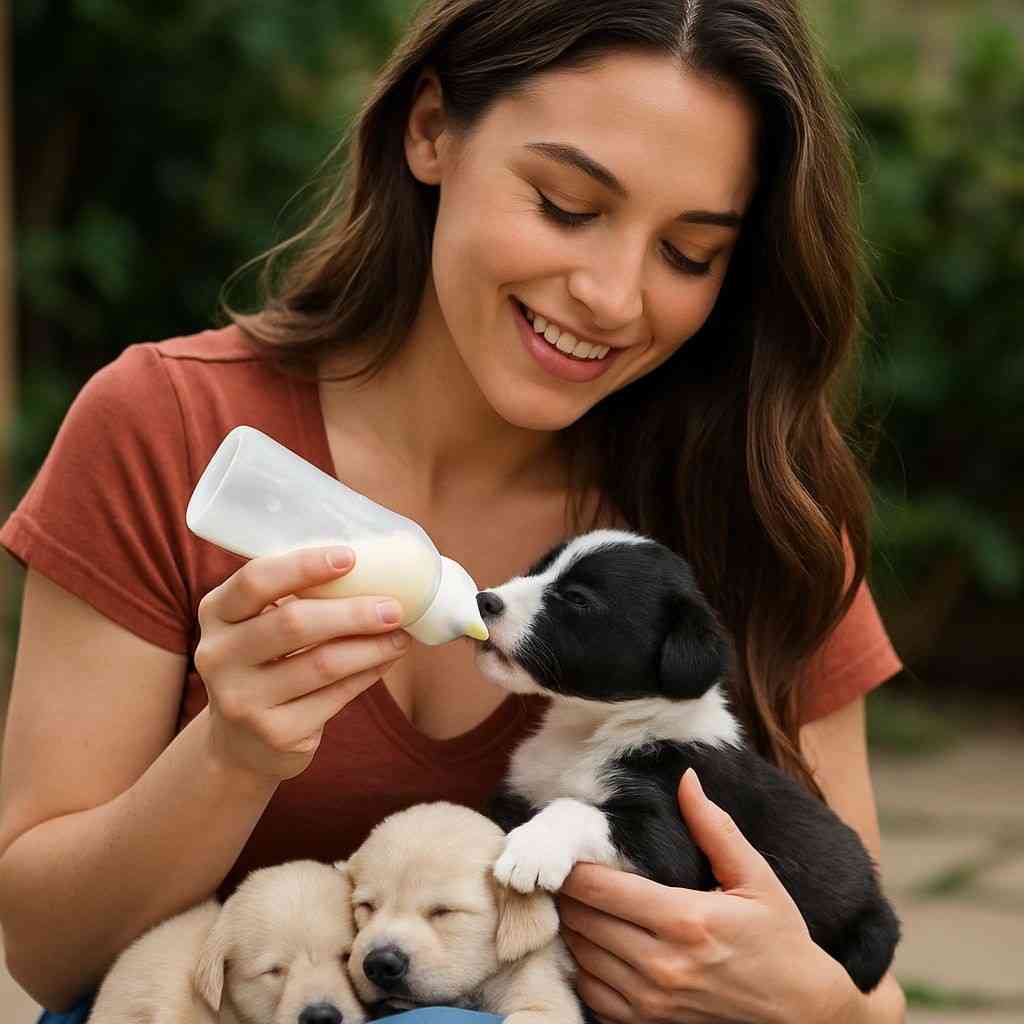
| What it is | Tools to feed orphan puppies safely. |
|---|---|
| Why it’s needed | Puppies cannot lap milk at birth, they suckle, so a nipple or syringe helps mimic mother’s teat. |
| Examples | Puppy nursing bottles (with small nipples), oral feeding syringe with soft tip. |
| How to use | Feed slowly, holding puppy upright or on belly (never on back to prevent aspiration). Clean after each use. |
Special Care When Using Nursing Bottles or Syringe
| Point to Care For | Why It’s Important? | What To Do? (Examples & Tips) |
|---|---|---|
| Cleanliness & Hygiene | Newborn puppies have weak immunity, risk of infection. | Always sterilize bottles, nipples, and syringes before each use by boiling or using puppy-safe disinfectant. Wash hands before handling. |
| Correct Size of Nipple/Tip | A nipple that’s too big or too small can choke or frustrate the puppy. | Use a small, soft nipple designed for puppies. The hole should allow milk to drip slowly when bottle is turned upside down — not stream out. |
| Proper Position of Puppy | Feeding in the wrong position can cause milk to enter lungs (aspiration pneumonia). | Always hold puppy on its belly (like it’s nursing from mom), never on its back. Head should be slightly raised. |
| Milk Temperature | Cold milk can chill the puppy; hot milk can burn. | Warm milk to about 38–39°C (100–102°F) — body temperature. Test on your wrist; it should feel just warm, not hot. |
| Feeding Speed & Amount | Feeding too fast or too much can cause bloating, diarrhea, or choking. | Let the puppy suckle at its own pace. Do not squeeze too much milk. Stop when puppy seems full and relaxed. |
| Monitor During Feeding | Puppies can aspirate, gag, or refuse to eat if unwell. | Watch for signs of coughing, milk coming from nose, or restlessness — if seen, stop feeding and consult a vet. |
| Burping (optional but helpful) | To release swallowed air and prevent discomfort. | After feeding, hold puppy upright and gently rub or pat its back for a few seconds. |
🛏️ 3. Soft Blankets & Bedding
Soft bedding has a crucial role for care for a puppy without mother.
| What it is | Clean, soft material to line the whelping box or basket. |
|---|---|
| Why it’s needed | Keeps puppies warm & dry, prevents skin sores, and provides comfort. |
| Examples | Fleece blankets, cotton towels, vet bedding material (non-slip, washable). |
| How to use | Change frequently to keep clean & dry; avoid loose threads that can tangle. |
Qualities of Good Soft Blankets & Bedding for Puppies
Care for a puppy without mother needs a good qualities of bedding and blankets.

| Quality | Why It’s Important? | Examples & Tips |
|---|---|---|
| Soft & Comfortable | Prevents skin irritation and provides warmth & comfort. | Use fleece, soft cotton, or vet bedding. Avoid rough or scratchy fabrics. |
| Warmth Retaining | Puppies can’t regulate body temperature well, so bedding should help retain heat. | Thick materials like fleece or layered towels work well. Can combine with a heating pad. |
| Absorbent | To soak up urine or spilled milk, keeping puppies dry. | Vet bedding or thick cotton blankets absorb moisture well. |
| Easy to Wash & Dry | Hygiene is critical — bedding must be washed often to prevent infections. | Choose machine-washable, quick-drying materials. Have several sets to rotate. |
| Non-toxic & Safe | Puppies chew & crawl — fabrics should not shed fibers or have harmful chemicals. | Avoid scented detergents, loose threads, or fabrics with buttons or zippers. |
| Non-slip/Stable | Puppies need a firm surface to crawl & strengthen muscles — bedding should not slide around. | Vet bedding has a rubberized backing; or place blankets over a non-slip mat. |
| Breathable | Prevents overheating while keeping puppies warm. | Light, layered materials are better than heavy, airtight covers. |
4. Heating Pad or Hot Water Bottle
Proper use of heating pad helps in proper care for a puppy without mother.
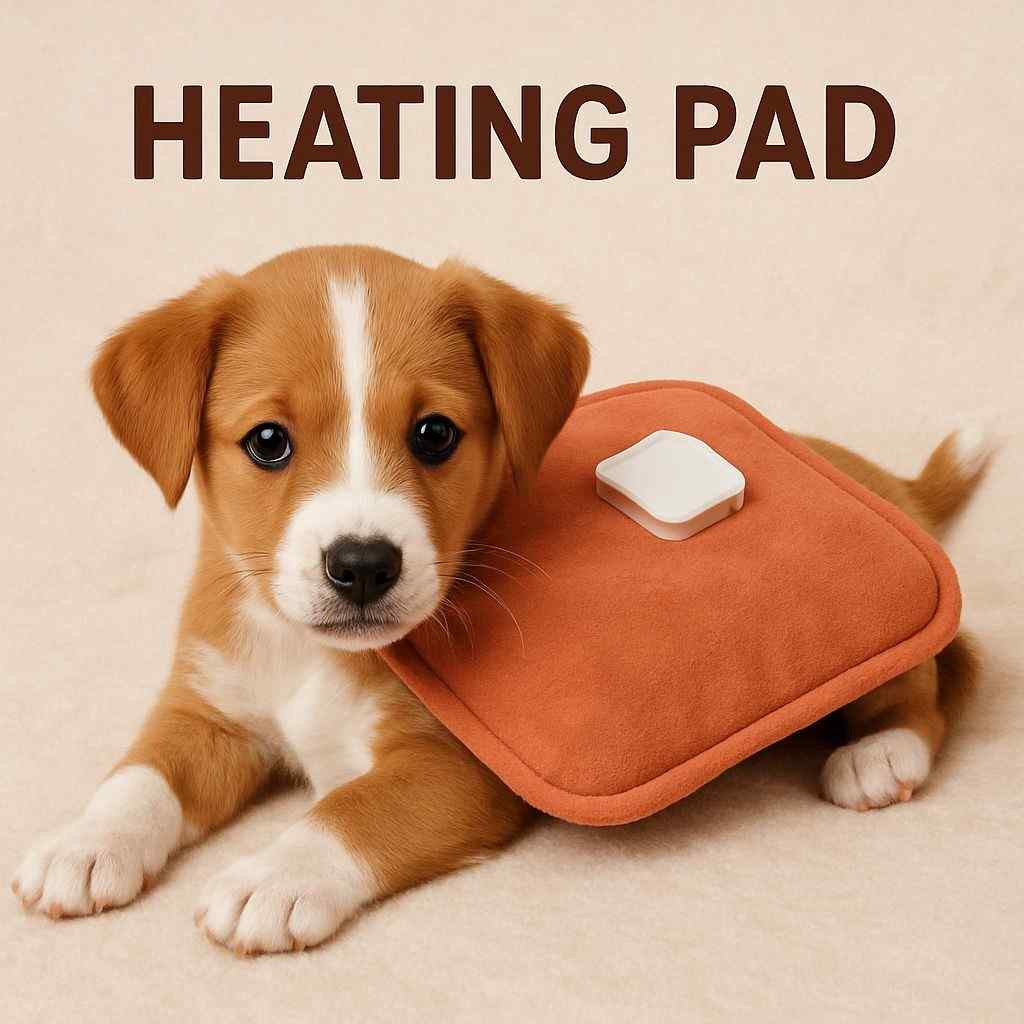
| What it is | Heat source to maintain puppies’ body temperature. |
|---|---|
| Why it’s needed | Newborns cannot regulate their body temp; risk of hypothermia without warmth. |
| Examples | Electric heating pad (on low, wrapped in cloth), hot water bottle, heat lamp (not too close). |
| How to use | Keep one area warm so puppies can move away if too hot; ideal temp ~30–32°C (86–90°F) in first week. |
Keeping the Puppy Warm — Temperature & Environment
Care for a puppy without mother by using good warm management practices is very important.
| Factor | Why It’s Important? | What To Do? (Examples & Tips) |
|---|---|---|
| 🌡️ Room/Box Temperature | Newborn puppies cannot regulate their body temperature. If too cold, they can die of hypothermia. | Keep whelping area at: ➡ 1st week: ~30–32°C (86–90°F) ➡ 2nd week: ~27–29°C (80–85°F) ➡ 3rd week: ~24–26°C (75–80°F) ➡ By 4 weeks, puppies can tolerate room temp (~22°C/72°F). |
| 🔥 Heat Source | To maintain proper warmth, especially if the mother is not there to cuddle with. | Examples: ✅ Heating pad (on LOW, under bedding, and cover it well to avoid burns) ✅ Hot water bottle (wrapped in towel) ✅ Heat lamp (hung ~60 cm/2 ft above box) |
| 🌀 Avoid Drafts | Cold air drafts can chill the puppies even if the room is warm. | Keep the box away from windows, fans, doors. Cover with a blanket partially to block drafts but allow some ventilation. |
| 🪟 Ventilation | Puppies need fresh air but not wind or excessive humidity. | Ensure the room is airy but stable in temperature. Don’t close the box completely. |
| 👶 Puppies’ Behavior as a Guide | Puppies’ body language tells you if the temperature is right. | Signs: ✅ Too cold: puppies pile up & cry loudly ✅ Too hot: puppies spread out, pant, and avoid heat source ✅ Just right: puppies sleep quietly & feel warm but not hot to the touch. |
| 🕒 Night & Monitoring | Temperature can drop at night when no one notices. | Use a thermometer in the whelping box & check it regularly. Have backup heat source ready. |
Signs of Temperature Trouble in Newborn Puppies
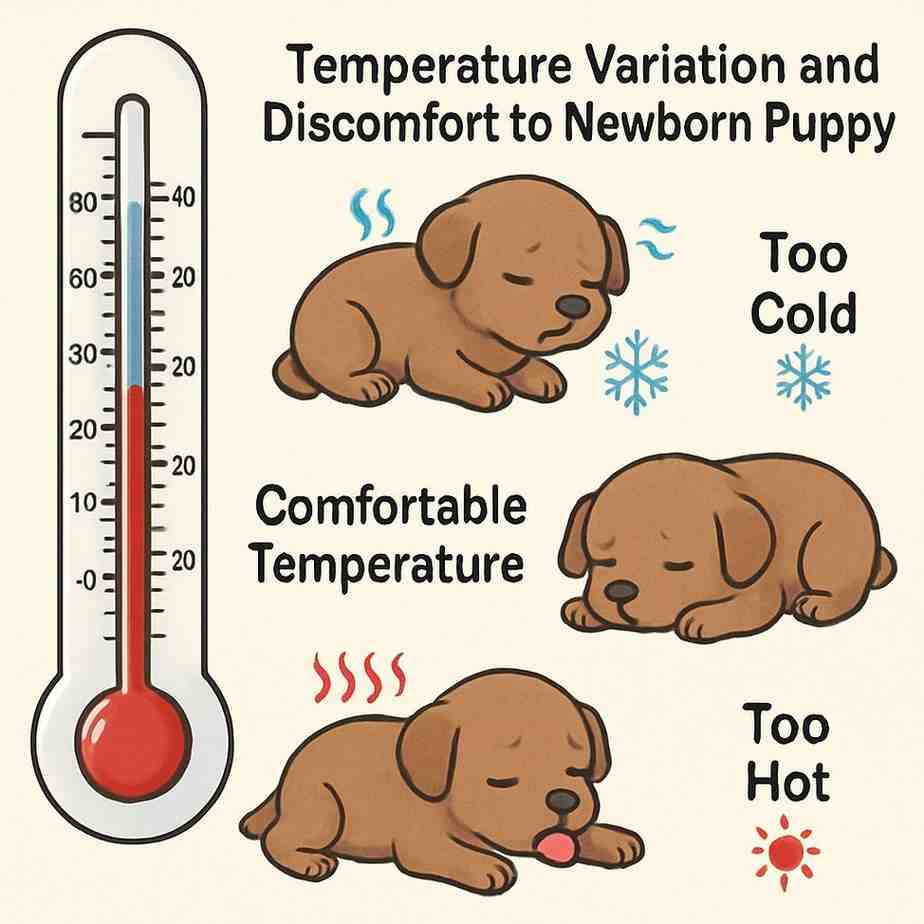
| Condition | Signs in the Puppy | What It Means | What To Do |
|---|---|---|---|
| ❄️ Too Cold (Hypothermia) | Puppies cry loudly, restless, and piling on each other. Body feels cool to touch, paws & ears are cold. Weak sucking reflex, lethargic or not moving much. -May shiver or appear stiff. | The puppy’s body temperature has dropped below normal (below ~35°C / 95°F). This is dangerous and can lead to death. | Warm the puppy gradually: ✅ Use a heating pad or hot water bottle (covered). ✅ Keep box temperature at ~30–32°C (86–90°F) in the first week. ✅ Call a vet if unresponsive. |
| 🔥 Too Hot (Hyperthermia/Overheating) | – Puppies are spread out far apart. – Panting or rapid breathing. – Skin feels hot or dry. – Weak or very quiet, unwilling to nurse. | Body temperature has risen above normal (above ~39°C / 102°F). Can also be dangerous. | Cool the area slightly: ✅ Move heat source farther away. ✅ Allow airflow but avoid drafts. ✅ Wipe puppy gently with a cool, damp cloth if needed. |
| ✅ Just Right (Normal) | – Puppies are quiet, sleeping, or nursing contently. – Skin feels warm (not hot), soft, and pink. – Puppies move around a little but seem calm. | Normal body temp (~35.5–37.5°C / 96–99.5°F in first week). | Keep environment steady & clean. Continue monitoring regularly. |
5. Cotton Balls & Soft Wipes
Cotton balls and soft wipes should be used carefully while taking care for a puppy without mother.
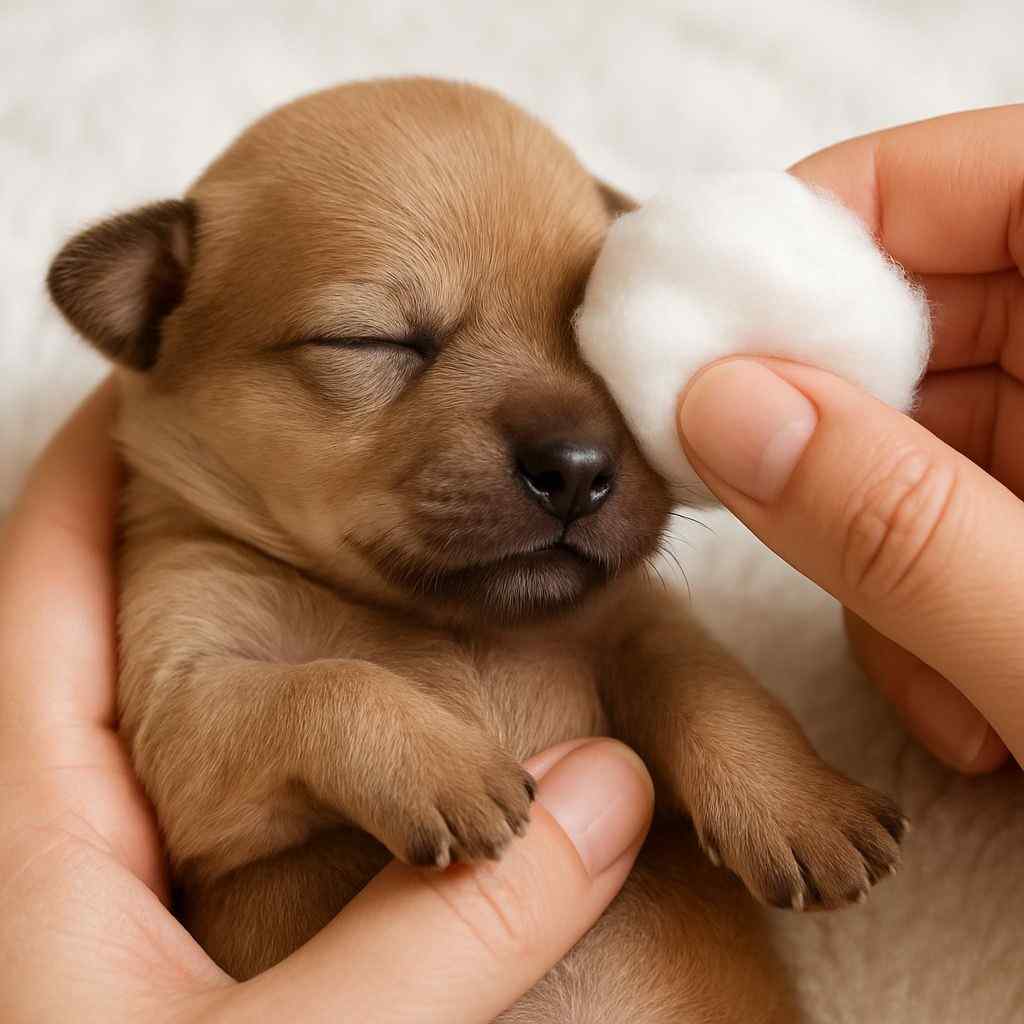
| What it is | Tools to stimulate and clean the puppy. |
|---|---|
| Why it’s needed | Mother usually licks puppies to stimulate urination & defecation. Orphans need help. |
| Examples | Plain cotton balls, soft tissue or baby wipes (unscented, no alcohol). |
| How to use | After each feeding, gently rub the genital/anal area to help them eliminate waste. |
6. Puppy-Safe Disinfectants
Safe and ecofriendly disinfectants should be used while doing care for a puppy without mother.
| What it is | Cleaning agents that kill germs but are safe for puppies. |
|---|---|
| Why it’s needed | Puppies have weak immune systems; clean area prevents infections. |
| Examples | Diluted chlorhexidine, diluted bleach (1:32), veterinary disinfectants like Virkon®. |
| How to use | Clean bedding, bottles, surfaces daily; rinse well and dry before use. Keep puppies away until dry. |
What Not to Feed Newborn Puppies
While giving care for a puppy without mother,these below mentioned factors must be focused because there is always chances of ill effects of some food products.
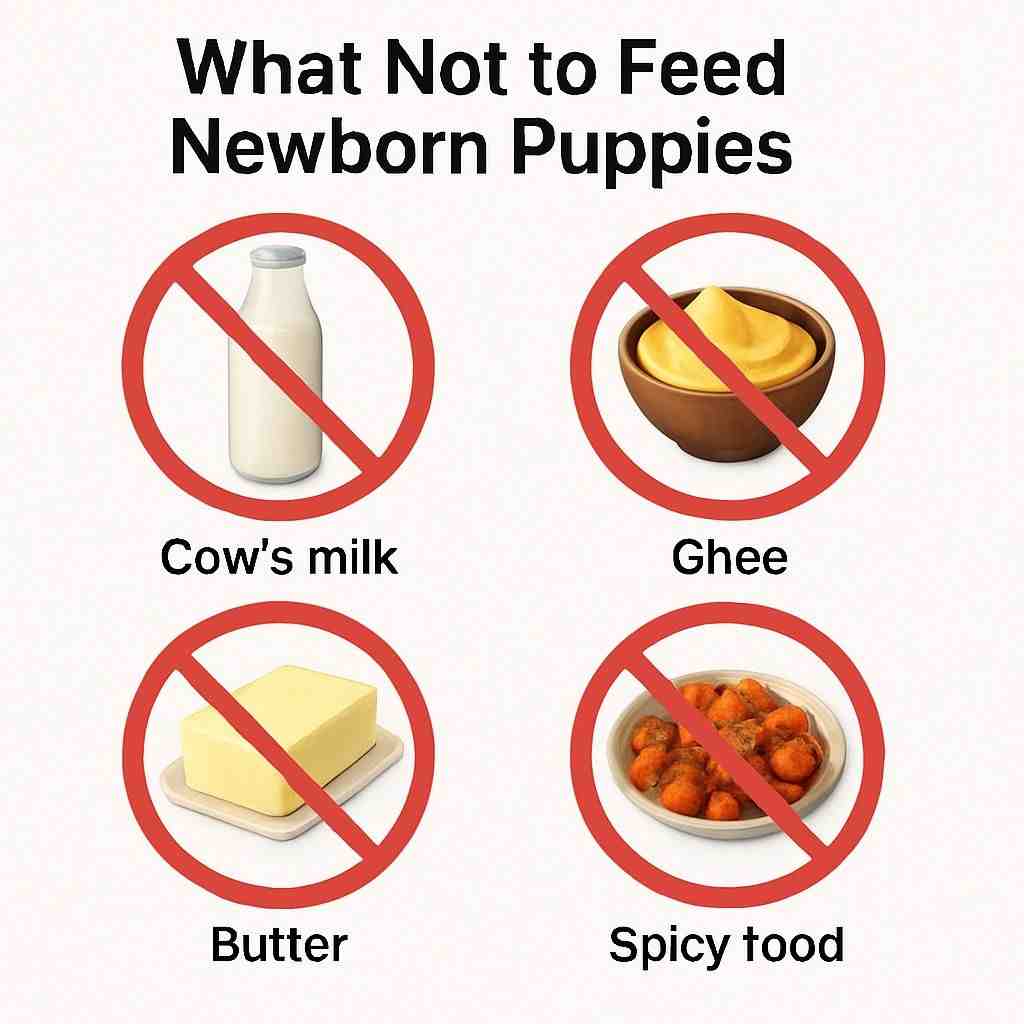
| Food/Drink | Example | Why It’s Harmful (Scientific Reason) |
|---|---|---|
| 🥛 Cow’s milk (or buffalo milk) | Raw or boiled cow milk from the kitchen. | Too high in lactose, and too low in protein & fat for puppies. Causes diarrhea, bloating, and poor growth. |
| 🥛 Condensed or sweetened milk | Tinned sweetened milk or milkmaid-type products. | Contains high sugar & lactose, which can cause diarrhea, dehydration, and obesity. |
| 🧈 Cream, butter, or ghee | Adding butter or cream to milk. | Very high fat — can upset the stomach and cause pancreatitis or diarrhea. |
| 🍫 Chocolate or sugary foods | Giving a taste of chocolate or sweets. | Chocolate contains theobromine, which is toxic to dogs and can cause heart problems and seizures. |
| 🍗 Solid foods too early | Giving meat, rice, biscuits before 3–4 weeks. | Puppies cannot chew or digest solids properly before 3–4 weeks; it can choke them or cause indigestion. |
| 🍼 Homemade formulas for too long | Using goat milk & egg yolk formula for weeks. | Not balanced — lacks essential nutrients like taurine, DHA, and proper minerals. Use only as an emergency, short-term solution. |
| 🧂 Salty or spicy food | Human food like curry, chips, or salty broth. | Puppies’ kidneys cannot handle excess salt, and spices irritate their digestive system. |
| 💊 Unprescribed supplements or vitamins | Giving calcium syrup, vitamins without a vet’s advice. | Over-supplementing can lead to bone problems, toxicity, or organ damage. |
Help The Puppy To Eliminate Waste (Urine & Stool)
Newborn puppies cannot urinate or defecate on their own for the first 2–3 weeks. Normally, the mother licks their genital & anal area to stimulate them. If not helped, the puppy can get constipated, bloated, or sick. While providing care for a puppy without mother they need our help.
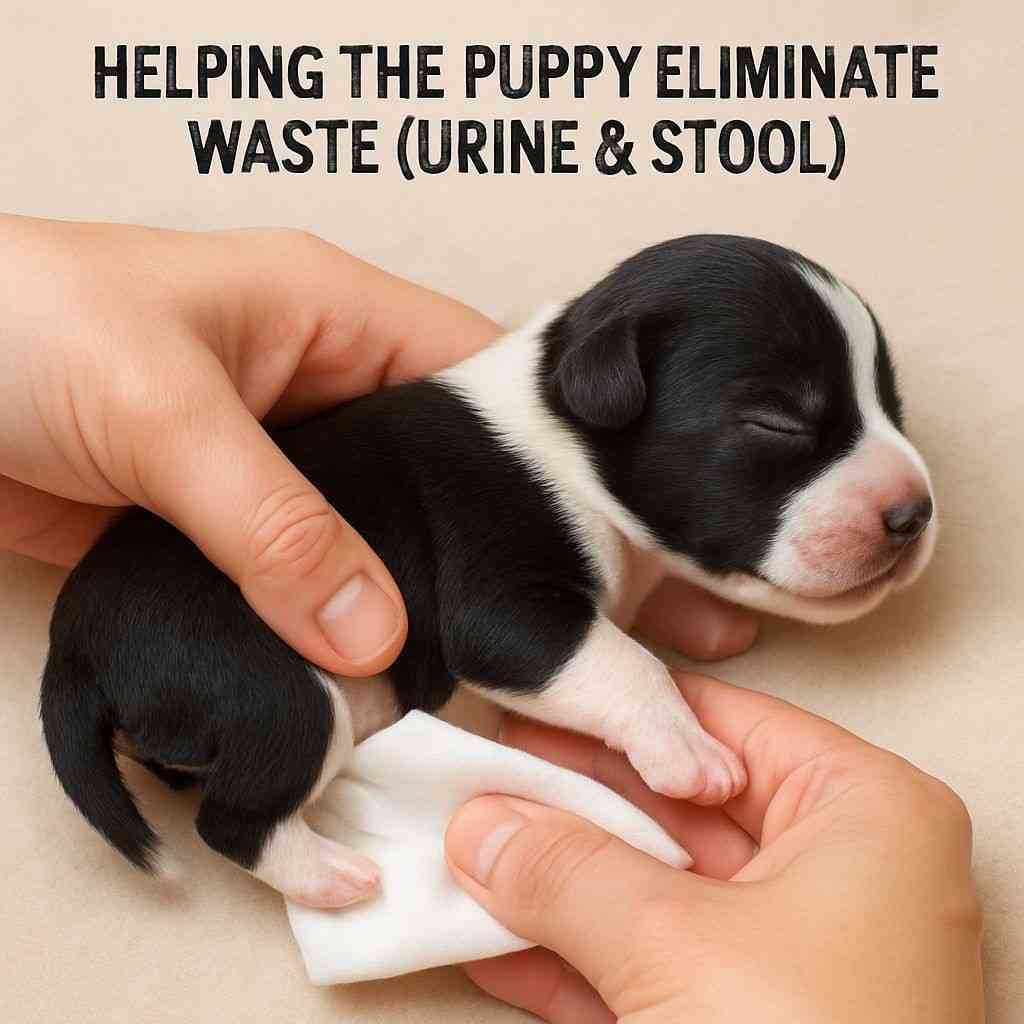
| Step | What to Do? | Examples & Tips |
|---|---|---|
| 1️⃣ | When to stimulate? | After every feeding — while the puppy is still awake. |
| 2️⃣ | What to use? | Soft, warm & damp material — e.g., a cotton ball, soft tissue, or clean baby wipe (unscented & alcohol-free). |
| 3️⃣ | Position the puppy | Hold the puppy on its belly (like crawling), or in your palm. Never on its back. |
| 4️⃣ | How to stimulate? | Gently rub or tap the area between the hind legs — around the genital & anal openings — with the warm damp cotton. |
| 5️⃣ | Observe the result | Puppy should urinate and/or pass a little stool within a few seconds. Keep wiping gently until no more comes out. |
| 6️⃣ | Clean up & comfort | Wipe the puppy dry with a soft cloth to avoid skin irritation. Make sure the area stays clean & warm. |
Different Reaction After Birth
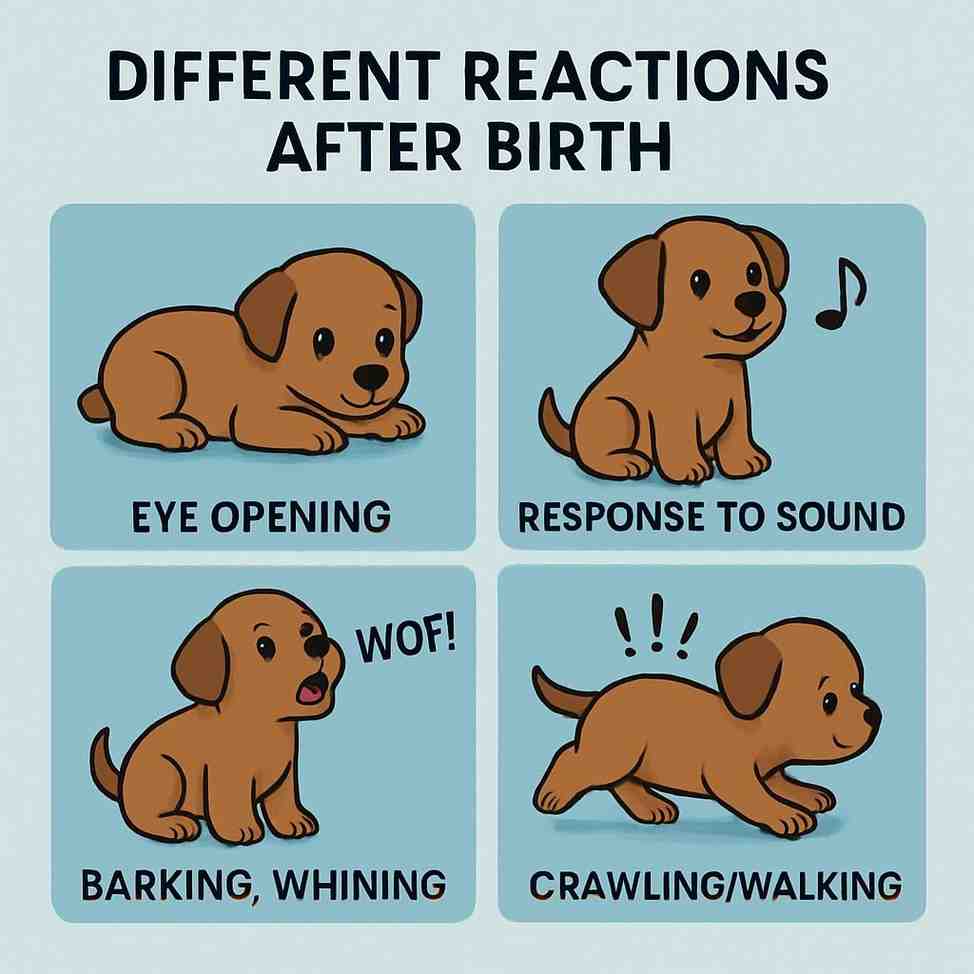
Newborn puppies undergo rapid developmental changes in the first few weeks after birth, including physical milestones like eye opening and behavioral responses like reactions to stimuli and vocalizations. So during care for a puppy without mother,we have to watch these activities at time to time.
| Developmental Activity | Timing | Description | Scientific Basis |
|---|---|---|---|
| Eye Opening | 10-14 days (1.5-2 weeks) | Puppies’ eyes begin to open, starting with a slight slit and fully opening by 2 weeks. Vision is initially blurry. | Eyes remain closed at birth to protect underdeveloped retinas. Opening occurs as the nervous system matures, enabling basic visual perception by 3 weeks. |
| Response to Sound | 2-3 weeks | Puppies start reacting to sounds (e.g., turning head toward noise) as their ear canals open. | Ear canals are closed at birth to prevent damage. By 2-3 weeks, auditory nerves develop, allowing puppies to detect and respond to sounds. |
| Vocalizations (Barking, Whining) | Birth (whining), 2-3 weeks (barking) | Newborns whine or cry to signal hunger, cold, or discomfort. Barking begins around 2-3 weeks as vocal cords develop. | Whining is an innate reflex to communicate needs. Barking emerges as the vocal tract matures, used for attention or play, influenced by socialization. |
| Startle Reflex | 1-2 weeks | Puppies show a startle response (e.g., twitching or jumping) to sudden touch or loud sounds. | The nervous system begins processing external stimuli, with the startle reflex indicating early sensory development. This reflex fades as puppies gain control. |
| Crawling/Walking | 2-3 weeks | Puppies start crawling at 1-2 weeks and attempt wobbly walking by 2-3 weeks. | Musculoskeletal development and neural coordination improve, enabling mobility. Walking strengthens as the cerebellum matures. |
| Social Interaction | 3-4 weeks | Puppies begin interacting with littermates, foster mother, or humans, showing play behaviors like nipping or pawing. | The socialization window (3-12 weeks) begins, with puppies learning canine social cues and bonding through oxytocin release during interactions. |
| Response to Touch | Birth (basic), 2-3 weeks (refined) | Newborns respond to touch (e.g., rooting for milk). By 2-3 weeks, they react more deliberately to petting or handling. | Tactile sensitivity is present at birth for survival (e.g., finding teats). Refinement occurs as the somatosensory cortex develops, enhancing responsiveness. |
| Temperature Regulation | 4-6 weeks | Puppies begin regulating their body temperature independently, no longer fully reliant on external warmth. | Thermoregulation develops as the hypothalamus matures, allowing puppies to maintain a body temperature of 36.1–38.3°C (97–101°F) without constant maternal warmth. |
| Weaning | 4-6 weeks | Puppies start transitioning from milk to solid food, guided by the foster mother or caregiver. | Digestive systems mature, enabling digestion of solid food. Weaning reduces dependency on the foster mother’s milk as nutritional needs increase. |
Special Aspects
- Orphaned Puppies: For puppies raised by a foster mother, these milestones align with natural development if the mother provides adequate care (e.g., nursing, stimulation). Hand-reared puppies may need extra support, such as manual stimulation for elimination until 3 weeks and careful introduction to stimuli to mimic maternal socialization.
- Variability: Timing can vary slightly by breed, health, and environment. Smaller breeds may develop faster, while larger breeds may take longer for some milestones (e.g., walking).
- Monitoring: Observe puppies for delays (e.g., eyes not opening by 16 days, no response to sound by 4 weeks) and consult a veterinarian if milestones are missed, as this could indicate health issues.
- Caregiver Role: For hand-reared puppies, caregivers must replicate maternal care (e.g., warmth via heating pads, stimulation for elimination) and introduce gentle handling and sounds to support socialization and sensory development.
Socialization And Bonding
Socialization and bonding are critical for care for a puppy without mother to ensure healthy behavioral and emotional development.
| Aspect | How to Do It | Why It’s Important |
|---|---|---|
| Gentle Handling | Handle puppies gently for 3-5 minutes daily, stroking them softly while speaking calmly. Start after 3 days of age. | Early handling reduces stress responses, promotes human trust, and stimulates neurological development through tactile stimulation. |
| Exposure to Foster Mother | Allow the puppy to interact with a foster mother (if available) for nursing, grooming, and physical contact. | The foster mother teaches canine social cues, provides comfort, and releases oxytocin during nursing, fostering emotional security. |
| Scent Introduction | Introduce the puppy to familiar scents (e.g., foster mother’s bedding, human caregiver’s clothing) by placing them in the nesting area. | Familiar scents reduce anxiety and help the puppy associate smells with safety, aiding bonding with caregivers and other animals. |
| Gradual Human Interaction | After 2 weeks, increase human interaction by holding, petting, and talking to the puppy in a calm environment. | Early positive human contact builds trust, reducing fearfulness and improving adaptability to human environments later in life. |
| Exposure to Sounds | Play soft, everyday sounds (e.g., household noises, gentle music) at low volumes starting at 2-3 weeks. | Gradual exposure to sounds prevents noise phobia and helps puppies adapt to varied environments, supporting behavioral resilience. |
| Sibling Interaction | If other puppies are present (e.g., foster mother’s litter), allow supervised play and contact after 3 weeks. | Interaction with littermates teaches social skills like bite inhibition and play behavior, crucial for healthy canine relationships. |
| Safe Environment Exploration | After 4 weeks, introduce puppies to new textures (e.g., soft blankets, grass) and safe objects in a controlled space. | Early exploration stimulates brain development, builds confidence, and prepares puppies for diverse environments. |
| Positive Reinforcement | Reward calm behavior with gentle praise or light petting during interactions, starting at 3-4 weeks. | Positive reinforcement strengthens emotional bonds and encourages desirable behaviors, reducing stress and fear. |
What To Do Regular
- Timing: 3-12 weeks is the critical socialization period for puppies. For newborns (0-3 weeks), focus on gentle handling and bonding with the foster mother or caregiver. After 3 weeks, slowly and gradually we can introduce more stimuli.
- Orphaned Puppies: If no foster mother is available, caregivers must act as maternal roles (e.g., warmth, stimulation for elimination) while slowly introducing socialization to avoid overwhelming the puppy.
- Regular Monitoring: Keep watching for signs of stress (e.g., excessive whining, trembling) and adjust exposure to ensure the puppy remains comfortable. Consult a veterinarian if behavioral issues arise.
- Maintain Consistency: Regular, short interactions (5-10 minutes daily) are more effective than prolonged or irregular ones to build trust and familiarity.
Transitioning Puppies to Solid Food (Weaning)
Like other puppies with mother transition of food from liquid to solid should be scientifically while giving care for a puppy without mother.
| Age of Puppy | What to Feed? | Examples & Tips |
|---|---|---|
| 🍼 0–3 weeks | Only mother’s milk or commercial milk replacer. | Feed every 2–3 hours. Puppies can’t digest solids yet. |
| 🍼➡🥣 3–4 weeks | Start introducing puppy gruel (soft, mushy food). | Example: Puppy kibble soaked in warm water or puppy milk replacer until mushy. Blend it if needed. Offer in a shallow dish. Still continue bottle/milk. |
| 🥣 4–5 weeks | Gradually thicken the gruel & increase solid content. | Reduce the liquid gradually so it becomes more like soft porridge. Puppies begin lapping & chewing more. |
| 🥩 5–6 weeks | Softened kibble & small amounts of canned puppy food. | Example: Soak puppy kibble lightly so it’s soft but not mushy. Puppies should nurse less now. |
| 🥗 6–8 weeks | Mostly solid puppy food — dry or canned. | Offer dry puppy kibble or canned food designed for puppies. Water should always be available. Nursing usually stops by 6–7 weeks. |
Tips for Smooth Weaning
✅ Always use high-quality puppy food — it has the right nutrients for growth.
✅ Feed in a shallow dish to prevent choking or spilling.
✅ Feed 3–4 times a day during weaning.
✅ Expect some mess — puppies may step into or play with the food at first.
✅ Monitor weight & energy — they should keep gaining weight steadily.
Common Health Problems & How to Check
Care for a puppy without mother can be done in a healthier way by regular monitoring of their health aspects.
| Health Problem | What Happens? | How to Check? (Signs to Look For) |
|---|---|---|
| ❄️ Hypothermia (Too Cold) | Puppy’s body temperature drops. Can’t digest milk properly or move much. | 🔹 Feel the puppy: cold body, cold paws & ears. 🔹 Crying, weak, not nursing, huddling tightly. |
| 💧 Dehydration | Puppy loses too much water — from diarrhea, not enough milk, or hot environment. | 🔹 Gently pinch the skin — if it stays up (not snapping back), puppy is dehydrated. 🔹 Dry mouth & gums, weakness. |
| 💩 Diarrhea | Loose, watery stools from wrong milk, infections, or stress. | 🔹 Check bedding: messy, smelly, wet with soft or liquid poop. 🔹 Puppy may look thin & cry more. |
| 🦠 Infections (Sepsis, pneumonia, etc.) | Bacteria or viruses can make puppies sick fast. | 🔹 Lethargic, not nursing, pale gums, difficulty breathing, swollen belly. 🔹 High or very low temperature. |
| 🐛 Parasites (worms, fleas, ticks) | Worms & insects steal nutrients & can make them sick. | 🔹 Bloated belly, diarrhea, poor weight gain. 🔹 Check fur for fleas or tiny black dots. |
| 🍼 Malnutrition (Not Enough Nutrition) | Not enough milk, poor quality milk, or not feeding often enough. | 🔹 Not gaining weight, weak, crying a lot, thin body. 🔹 Weigh daily — if weight doesn’t go up, they’re not getting enough. |
| 🫁 Aspiration Pneumonia | Milk accidentally enters lungs during feeding. | 🔹 Coughing, nasal discharge (milk comes out nose), breathing fast or noisy, weak. |
When Can the Puppy Be Adopted or Left Alone?
Determining when a puppy, especially an orphaned one raised with a foster mother or caregiver, can be adopted or left alone depends on its physical, emotional, and behavioral development.Adoption is best method to provide care for a puppy without mother.
| Aspect | When It Can Happen | Scientific Basis | Considerations |
|---|---|---|---|
| Adoption | Typically 8 weeks or older. Puppies should not be adopted before this age to ensure proper development. | By 8 weeks, puppies are usually weaned, have developed basic social skills, and have stronger immune systems due to maternal antibodies (from foster mother’s milk or colostrum). Early separation (before 6-7 weeks) can lead to behavioral issues like anxiety or aggression. | – Ensure the puppy is eating solid food consistently and gaining weight (10-15% daily in the first week, then steady growth). – Verify the puppy has had initial vaccinations and deworming. – Confirm socialization with humans and other dogs has begun to ease the transition to a new home. |
| Left Alone (Short Periods) | 12-16 weeks, for short durations (1-2 hours). Puppies under 12 weeks should not be left alone due to their dependency. | Puppies younger than 12 weeks lack bladder control (can hold for ~1 hour per month of age) and need frequent feeding, stimulation, and socialization. By 12-16 weeks, they can tolerate brief solitude if basic needs are met. | – Provide a safe, confined space (e.g., crate or puppy-proofed area) with water, toys, and a comfortable bed. – Gradually introduce alone time to prevent separation anxiety. – Ensure the puppy has been fed, exercised, and relieved before being left alone. |
| Left Alone (Longer Periods) | 6 months or older, for 4-6 hours, depending on the puppy’s maturity and training. | By 6 months, puppies have better bladder control (up to 6 hours) and can self-regulate emotionally if properly socialized. Prolonged isolation before this can cause stress, leading to destructive behavior or anxiety. | – Continue crate training or use a secure area to prevent accidents or chewing. – Provide mental stimulation (e.g., puzzle toys) to keep the puppy occupied. – Monitor for signs of stress (e.g., excessive barking, chewing) and adjust duration if needed. |
Deworming and Vaccination Schedule for Newborn Puppies
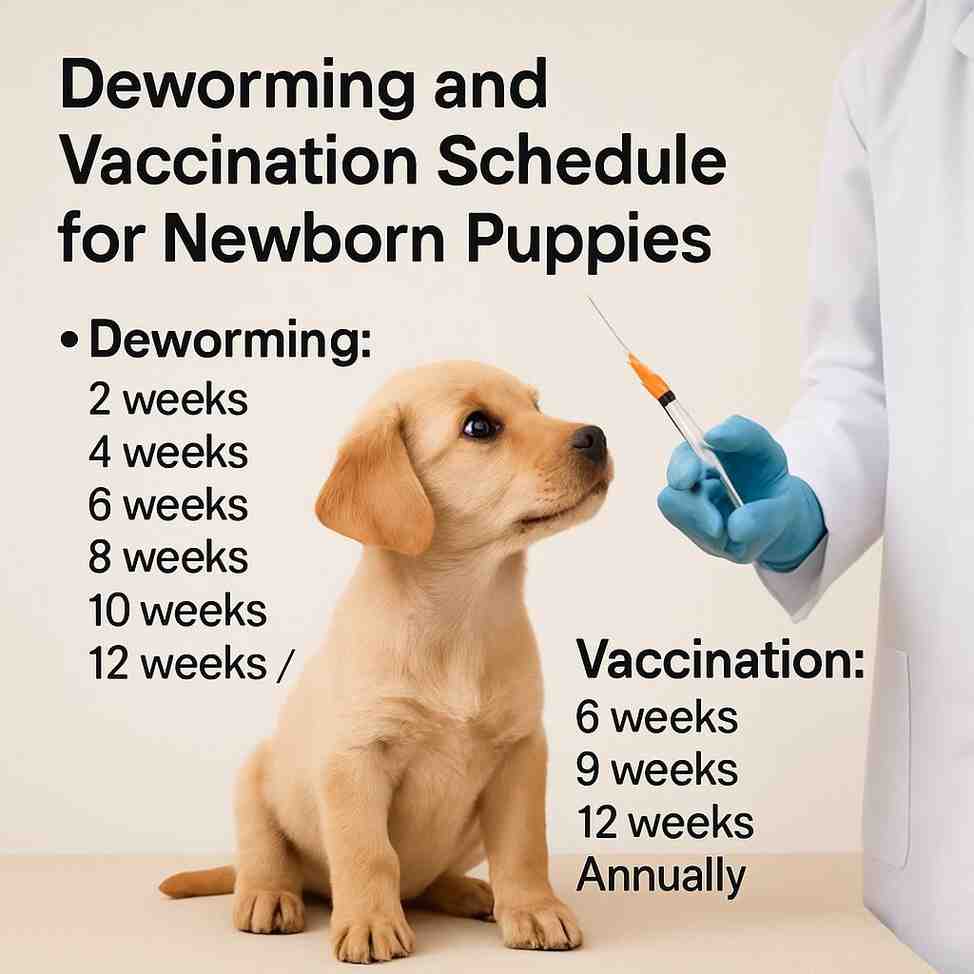
| Age | Procedure To Do | Details | Purpose | Considerations |
|---|---|---|---|---|
| 2 Weeks | Deworming | Administer a vet-prescribed dewormer (e.g., pyrantel pamoate). | Eliminates common intestinal parasites like roundworms and hookworms, often transmitted via the mother’s milk or placenta. | Use a puppy-safe dewormer. Weigh the puppy to ensure correct dosage. Repeat every 2 weeks until 8 weeks, as puppies are highly susceptible to reinfection. |
| 4 Weeks | Deworming | Second dose of dewormer (e.g., pyrantel or fenbendazole). | Continues parasite control, targeting any remaining or newly hatched worms. | Monitor for signs of parasites (e.g., bloated belly, diarrhea). Consult a vet if symptoms persist. |
| 6 Weeks | Deworming + First Vaccination (Optional) | Deworming: Third dose of dewormer. Vaccination: Early distemper-parvovirus combo (if high-risk environment). | Deworming prevents parasite-related malnutrition. Early vaccination protects against parvovirus in high-risk settings (e.g., shelters). | Early vaccines are uncommon unless disease risk is high. Ensure the puppy is healthy (no fever, good weight gain) before vaccinating. |
| 8 Weeks | Deworming + Core Vaccination | Deworming: Fourth dose of dewormer. Vaccination: First core vaccine (DHPP: distemper, hepatitis, parainfluenza, parvovirus). | Deworming maintains parasite-free growth. DHPP protects against life-threatening viral diseases. | Schedule with a vet for accurate administration. Puppies should be weaned and eating solid food for optimal vaccine response. |
| 10 Weeks | Deworming | Fifth dose of dewormer, possibly switching to a broader-spectrum product (e.g., fenbendazole). | Targets persistent or new parasites, ensuring healthy development. | Check fecal samples with a vet to confirm parasite clearance. |
| 12 Weeks | Core Vaccination + Rabies (Optional) | Vaccination: Second DHPP booster. Rabies: Administer if required by local laws or vet recommendation. | DHPP booster strengthens immunity. Rabies vaccine protects against a fatal zoonotic disease. | Rabies vaccination timing varies by region (some delay until 16 weeks). Ensure the puppy is healthy before vaccinating. |
| 14 Weeks | Deworming | Sixth dose of dewormer, if needed, based on vet advice. | Ensures complete parasite elimination as puppies become more active and exposed. | May transition to monthly preventatives (e.g., heartworm medication with deworming properties). |
| 16 Weeks | Core Vaccination + Rabies (if not given) | Vaccination: Final DHPP booster. Rabies: Administer if not given at 12 weeks. | Completes initial DHPP series for long-term immunity. Rabies ensures legal compliance and protection. | Schedule annual boosters for DHPP and rabies (or as per local regulations). Maintain monthly deworming/heartworm prevention. |
Conclusion
Nurturing and providing care for a puppy without mother represents an experience of dedication, devotion, and understanding that will turn dependents into puppies capable of being loved and coming alive. While undertaking the role as guardian—be it as a foster mother, or by closely monitoring your hand-rearing practices—you provide much more than food and shelter. This selfless act not only saves a fragile life but also fills your heart with the profound joy of watching a puppy thrive, ready to bring happiness to a forever home. In giving them a chance to grow, you create a legacy of love that lasts a lifetime.
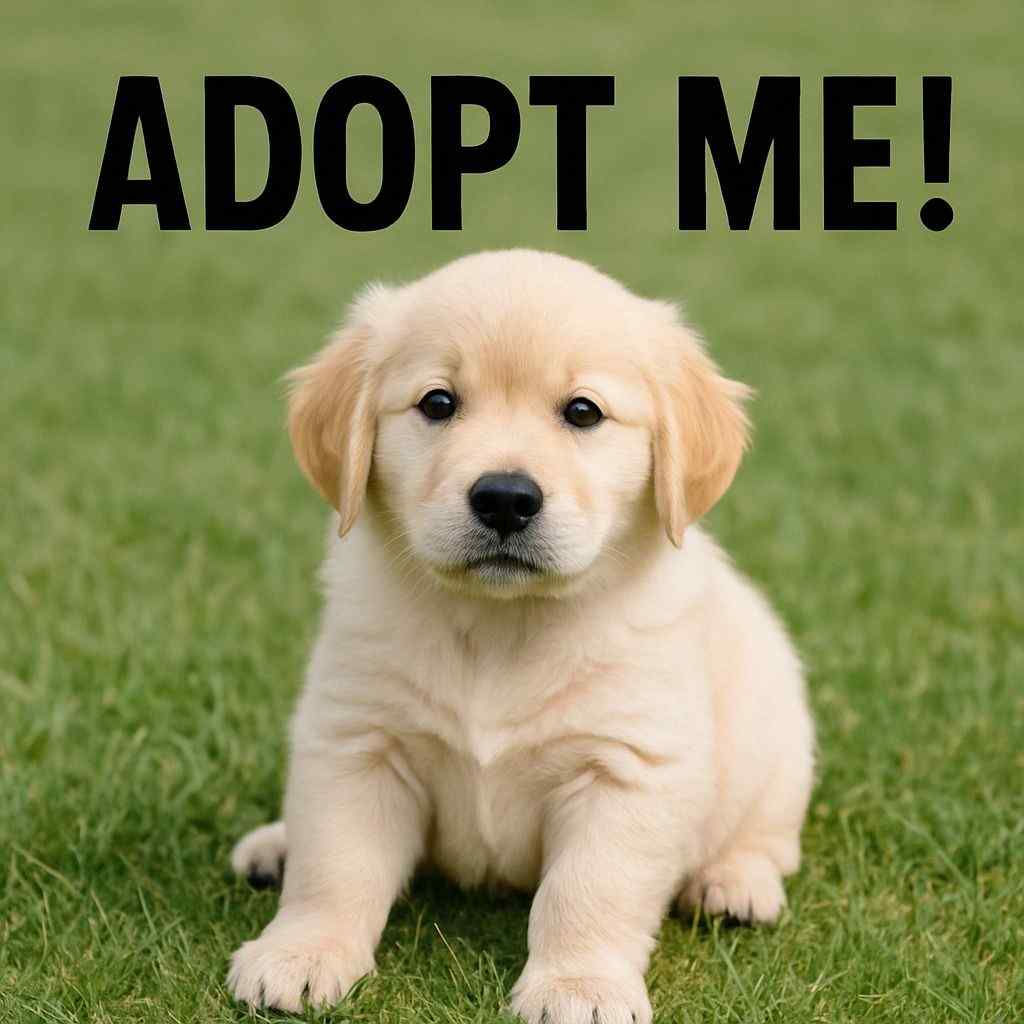
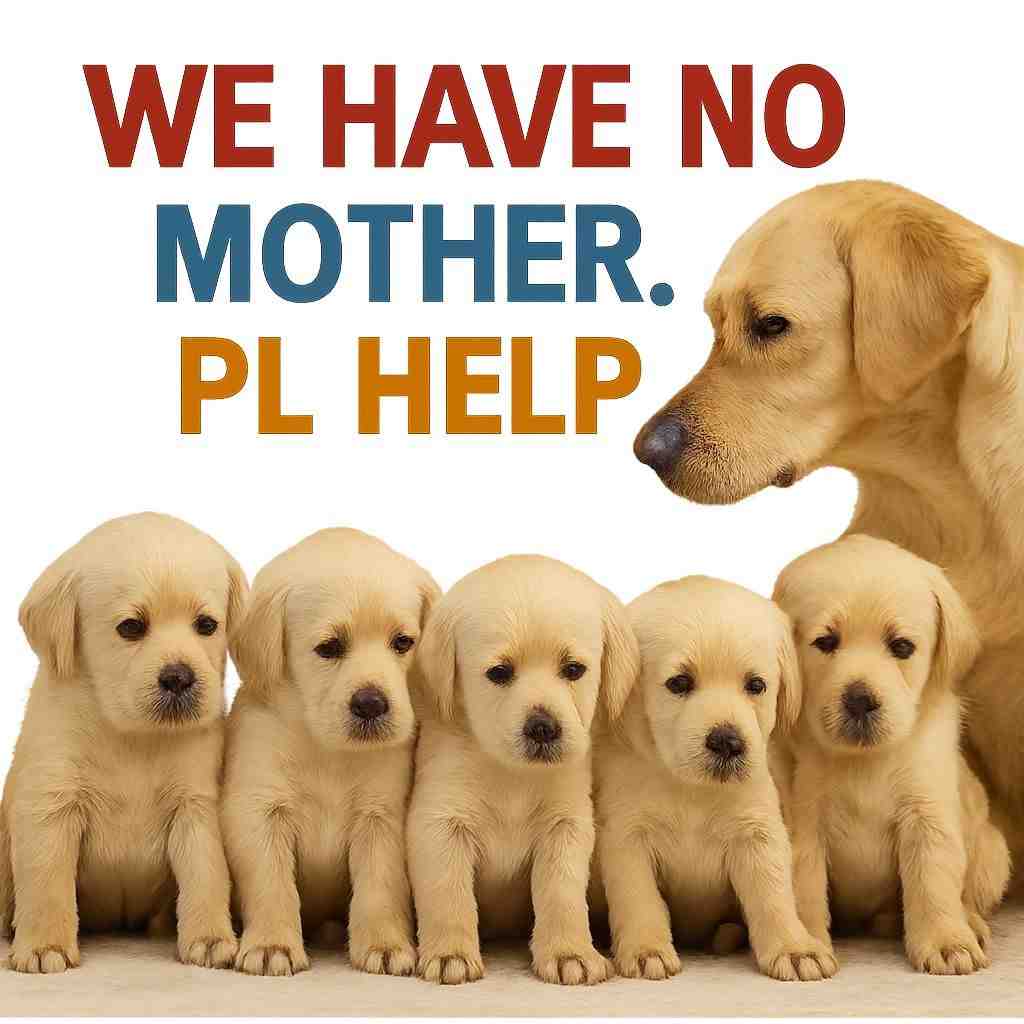
1 thought on “How to Care for a Puppy Without Mother: A Complete Guide”